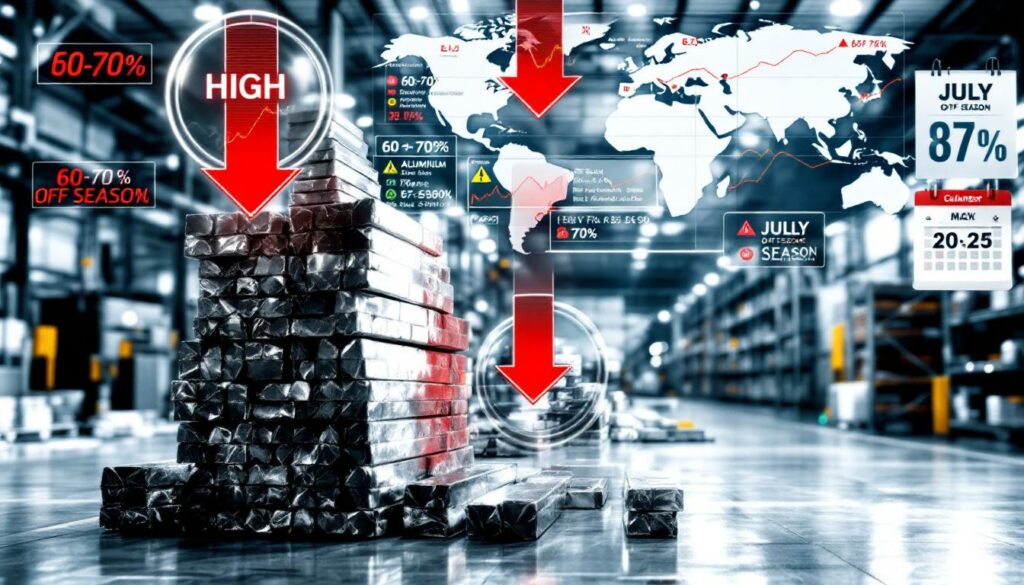How Are Global Economic Factors Affecting Aluminum Prices?
The aluminum market is currently navigating through significant headwinds as three major pressures converge to suppress prices. Trade tensions have emerged as perhaps the most immediate concern, with recent announcements about potential tariffs of 60-70% scheduled to begin on August 1, 2025. These protectionist measures targeting multiple countries have sent ripples through global metal markets, heightening risk aversion among traders and investors.
"The announcement of potential high tariffs, coupled with the reported deadlock in international trade negotiations, has created a perfect storm of uncertainty in aluminum markets," notes SMM's latest macro analysis report.
Trade Tensions and Tariff Threats
The aluminum industry finds itself caught in the crossfire of broader geopolitical tensions. U.S. Treasury Secretary Bessent's recent comments about a "deadlock in final-stage trade talks" have only intensified market concerns. These developments come at a particularly sensitive time for the aluminum supply chain, which has already been grappling with regional imbalances and shifting production strategies.
The proposed tariffs represent a significant escalation from previous trade measures and could fundamentally reshape global aluminum trade flows. Market participants are particularly concerned about aluminum tariff impact and retaliatory measures that could further fragment the global market.
Manufacturing Activity Indicators
Despite the tariff concerns, there are some glimmers of resilience in the broader economic landscape. The global manufacturing PMI reached 49.5% in June 2025, representing a 0.3 percentage point improvement from May. However, this figure remains below the critical 50% threshold that separates expansion from contraction, indicating that manufacturing activity worldwide continues to struggle.
This below-expansion PMI reading provides limited support for aluminum demand, as key downstream sectors such as automotive, construction, and consumer durables continue to operate below optimal capacity. The correlation between manufacturing activity and aluminum consumption remains strong, with approximately 75% of aluminum demand tied directly to industrial applications.
Inventory Dynamics and Price Support
While other factors exert downward pressure, the current inventory situation provides some counterbalance. Primary aluminum ingot inventory in major consumption areas stood at 478,000 metric tons as of July 7, 2025—a modest increase of 10,000 metric tons from the previous week but still relatively low by historical standards.
This tight supply situation continues to provide underlying support for aluminum prices. According to industry analysts, current inventory levels represent approximately 12 days of consumption, compared to the five-year average of 18 days, creating a buffer against more dramatic price declines.
Key inventory metrics to monitor:
- Current inventory: 478,000 metric tons
- Weekly change: +10,000 metric tons
- Historical context: 33% below five-year average
- Days of consumption: ~12 days (versus 18-day historical average)
What's Happening in the Aluminum Production Landscape?
The production side of the aluminum equation reveals strategic adjustments by producers in response to changing market dynamics. These shifts provide important insights into how the industry is adapting to the triple pressures of trade tensions, manufacturing weakness, and seasonal demand patterns.
Casting Ingot Production Increases
A notable shift has emerged in recent weeks, with aluminum smelters in certain regions increasing their casting ingot production. This adjustment represents a tactical response to evolving demand patterns, as smelters attempt to optimize their product mix to match current market requirements.
The pivot toward casting ingots is particularly significant because it indicates producers are responding to signals from specific downstream sectors, potentially automotive and industrial applications, where demand patterns differ from other aluminum-consuming industries. This production flexibility demonstrates the adaptive capacity of modern smelting operations.
Cost Structure Developments
The economics of aluminum production continue to evolve, with real-time production costs for electrolytic aluminum declining month-over-month. This cost reduction puts additional pressure on market prices, as it effectively lowers the floor price needed for operational viability.
While potentially beneficial for producer margins in the short term, these cost reductions may ultimately contribute to downward price pressure if they enable increased production. The aluminum cost curve has historically provided important support levels for prices, but the shifting nature of this curve complicates price forecasting.
Cost components showing significant movement:
- Energy inputs: Declining by approximately 5% month-over-month
- Alumina pricing: Stabilizing after Q1 volatility
- Carbon material costs: Minor declines due to improved supply
Regional Price Differentials
Geographic price variations continue to play an important role in market dynamics. The price spread between central China and east China markets has narrowed to 150 yuan/mt recently, representing a contraction of 20 yuan/mt week-over-week.
These regional price differentials reflect localized supply-demand imbalances and logistical considerations. Transportation constraints, regional power pricing differences, and local inventory situations all contribute to these geographic spreads, which serve as important indicators of market stress points.
How Is Seasonal Demand Affecting the Market?
The traditional summer off-season has arrived in full force, adding seasonal pressure to the aluminum market already contending with trade and manufacturing headwinds. This cyclical pattern, while expected, is amplifying the effect of other market challenges.
Pronounced Off-Season Impact
July has ushered in the traditional summer slowdown across downstream aluminum-consuming sectors. This seasonal pattern, well-established in the industry calendar, is characterized by reduced activity in construction, consumer goods manufacturing, and certain industrial applications.
What makes this year's off-season particularly impactful is its coincidence with persistently high aluminum prices, creating a double challenge for downstream manufacturers. The combination has further suppressed production performance in aluminum-consuming industries, resulting in weaker-than-typical spot market transactions.
Inventory Accumulation Patterns
The seasonal demand weakness is reflected in the gradual build-up of inventories across key consumption hubs. Current data shows aluminum inventories standing at 144,000 mt in Guangdong, 120,000 mt in Wuxi, and 72,000 mt in Gongyi, for a combined total of 336,000 mt across these three key areas.
This inventory distribution provides valuable insights into regional demand patterns. The concentration in Guangdong highlights the continued importance of export-oriented manufacturing in that region, while the Wuxi figures reflect its status as a domestic consumption hub.
Weekend Purchasing Behavior
Despite the overall weak demand environment, an interesting pattern has emerged in transaction timing. Slight improvements in activity have been observed ahead of weekends, as downstream enterprises engage in limited stockpiling to ensure operational continuity.
This weekend procurement pattern suggests that while overall consumption remains subdued, there are still periodic inventory management needs that provide temporary support to market activity. These micro-cycles within the broader seasonal pattern create short-term trading opportunities for market participants.
What's Happening in the Secondary Aluminum Sector?
The secondary aluminum market faces its own unique set of challenges as it navigates the broader market pressures. As a segment that serves as both a complement and alternative to primary aluminum, its dynamics provide important insights into overall market health.
Scrap Market Dynamics
The aluminum scrap market has responded to movements in primary aluminum prices with modest adjustments of its own. Baled UBC (used beverage can) aluminum scrap prices have decreased by approximately 50 yuan/mt month-over-month, with current quoted prices ranging from 15,300 to 15,800 yuan/mt (tax-exclusive).
Interestingly, regional responses to primary aluminum price movements have varied significantly. Some areas have shown immediate price adjustments, while others have maintained relatively stable quotations. This geographic divergence reflects differences in local collection networks, transportation infrastructure, and regional processing capacity.
Price Spreads Between Primary and Secondary Materials
The relationship between primary and secondary aluminum markets can be quantified through price differentials, which have shown notable movement recently. The price spread between A00 aluminum and mixed aluminum extrusion scrap (free of paint) in Foshan narrowed by 90 yuan/mt month-over-month to 1,767 yuan/mt.
Similarly, the price gap between mechanical casting aluminum scrap and A00 aluminum in Shanghai contracted by 10 yuan/mt to 1,836 yuan/mt. These narrowing spreads indicate changing economics in the relationship between primary and secondary markets, potentially signaling shifts in relative value or processing costs.
Secondary Aluminum Alloy Production Challenges
Secondary aluminum alloy manufacturers are currently caught in a difficult position, facing pressure from both sides of their operation. Raw material supply deficits create challenges on the input side, while weak market demand constrains output options.
This challenging environment has prompted some producers to implement adaptive strategies, including temporary production halts for maintenance or reduced operating rates. Despite these adjustments, the spot market for ADC12 alloy has remained relatively stable within the range of 20,000 to 20,200 yuan/mt, showing resilience despite the downward movement in primary aluminum prices.
This price stability in the face of primary aluminum weakness suggests underlying cost support or niche market demand that continues to provide a floor for secondary alloy pricing.
What Are the Futures Market Indicators Telling Us?
Futures markets provide valuable forward-looking indicators for aluminum price trends. Recent performance across both domestic and international exchanges offers important clues about market sentiment and directional bias.
SHFE Aluminum Contract Performance
The most-traded SHFE aluminum 2508 contract has been showing signs of pressure in recent sessions. On July 7, the contract opened at 20,595 yuan/mt, reaching an intraday high of 20,625 yuan/mt before closing at 20,545 yuan/mt, reflecting intraday weakness.
Trading volume stood at 49,000 lots with open interest at 267,000 lots, indicating active market participation despite the challenging price environment. This combination of price action and volume metrics suggests continued interest in the market even as prices face downward pressure.
LME Aluminum Price Movements
The international picture mirrors domestic trends, with LME aluminum displaying similar signs of pressure. The LME contract opened at $2,600/mt, fluctuating between a high of $2,608.5/mt and a low of $2,582/mt before closing at $2,597.5/mt.
These synchronized movements across global exchanges reflect the interconnected nature of aluminum markets and the common fundamental and macroeconomic factors influencing prices worldwide. The US-China trade tensions underscores the global nature of the current market challenges.
Futures-Spot Relationship
The relationship between futures and physical markets provides important insights into immediate market conditions. Recently, spot discounts have expanded slightly, indicating growing pressure in the physical market relative to futures.
In east China, the market continued to offer at a discount of -20 to -10 yuan/mt against SMM in the morning session, with transactions gradually shifting from SMM-10 to SMM-20 as the day progressed. This widening discount reflects the current imbalance between supply and demand fundamentals in the physical market.
What Are the Import-Export Market Dynamics?
Cross-border aluminum flows provide another dimension to market analysis, with import-export economics influenced by both domestic and international factors. Current conditions present challenges for aluminum imports while creating potential opportunities for exports.
Import Economics for Secondary Aluminum
The import market for secondary aluminum remains challenging from an economic perspective. The CIF quoted price for imported ADC12 has remained stable at $2,450 to $2,480 per metric ton, while the imported spot price hovers around 19,200 yuan/mt.
This price relationship results in an immediate import loss of approximately 800 yuan/mt, creating an unfavorable situation for importers. This persistent negative import margin continues to limit the flow of secondary aluminum into the domestic market, effectively isolating domestic prices from international pressures.
Import economics breakdown:
- CIF price: $2,450-2,480/mt
- Domestic equivalent: ~19,200 yuan/mt
- Import loss: ~800 yuan/mt
- Trend: Persistent negative margin
International Price Comparisons
International price benchmarks show varied regional dynamics that influence trade flows. In Thailand, for example, the local tax-exclusive quoted price for ADC12 is concentrated within the range of 82-83 Thai baht/kg.
These international price points provide important reference points for market participants engaged in cross-border trade. The differentials between regional prices, when adjusted for transportation and customs costs, determine the viability and direction of potential trade flows.
What's the Market Outlook for Aluminum?
The convergence of trade tensions, manufacturing weakness, and seasonal factors creates a challenging environment for aluminum prices in the near term. However, structural elements of the market continue to provide some underlying support.
Short-Term Price Expectations
The aluminum market faces intensified downward pressure in the short term due to the three key factors we've explored: expectations of inventory buildup, weakening consumption, and macroeconomic uncertainties.
While current low inventory levels continue to provide some price support, the upside potential appears limited in the near term. The tariff effects on investments are skewed to the downside as the market navigates these challenging conditions, with potential price stabilization more likely to emerge as seasonal factors begin to shift later in the quarter.
Key Monitoring Indicators
Market participants should closely monitor several key indicators in the coming weeks to gauge the evolving market balance. Casting ingot production volumes will provide insights into producer strategies, while inventory changes will signal the pace of demand recovery or further weakening.
Additionally, regional price differentials deserve close attention as they may highlight emerging stress points or areas of relative strength within the broader market. Widening regional spreads often precede more significant market moves, making them valuable early warning indicators.
Cost Support Dynamics
Despite current price pressures, the underlying cost support logic remains intact for both primary and secondary aluminum. Production economics continue to provide a fundamental basis for price stability, even as the market navigates the current challenging environment.
For primary aluminum, energy costs, alumina pricing, and carbon material expenses establish a production cost floor that ultimately limits downside price potential. Similarly, for secondary aluminum, scrap acquisition costs, processing expenses, and quality control requirements create a minimum viable price point.
FAQ About the Current Aluminum Market
Why are aluminum prices facing downward pressure despite low inventory levels?
Aluminum prices are experiencing downward pressure despite relatively low inventory levels due to a combination of factors working against the typically supportive effect of tight supply. Expectations of inventory buildup as seasonal demand weakens are creating forward-looking pressure, while increasing production of casting ingots and declining production costs are expanding available supply.
Additionally, macroeconomic uncertainties—particularly potential new tariffs of 60-70%—are generating risk aversion among market participants. These factors collectively outweigh the support from current low inventories, which stand at 478,000 metric tons (still 33% below the five-year average).
How are secondary aluminum producers responding to current market conditions?
Secondary aluminum producers are implementing a range of adaptive strategies to navigate the challenging market environment. Many have temporarily halted production for maintenance or reduced operating rates to align output with weaker demand. This operational flexibility represents a key advantage of secondary production, which can adjust more rapidly than primary smelting.
These producers face a difficult balancing act between raw material constraints and weak downstream demand. Some are focusing on higher-margin specialty alloys where demand remains more resilient, while others are optimizing their scrap input mix to maintain profitability despite price pressures.
What regional differences exist in the aluminum market response?
Regional variations in the aluminum market are significant and provide important insights into localized supply-demand dynamics. The price spread between central China and east China has narrowed to 150 yuan/mt, reflecting evolving regional balances. Meanwhile, scrap aluminum price adjustments have varied by region, with some areas immediately following primary aluminum price movements and others maintaining stable quotations.
Inventory distributions also show regional patterns, with Guangdong holding 144,000 mt, Wuxi 120,000 mt, and Gongyi 72,000 mt. These differences reflect varying industrial concentrations, logistics networks, and consumption patterns across regions.
How might potential new tariffs impact the global aluminum market?
The potential implementation of tariffs ranging from 60-70% could significantly disrupt global aluminum trade flows, creating far-reaching consequences throughout the supply chain. Such measures would likely lead to market fragmentation, with regional price disparities widening as trade patterns adjust to the new reality.
For producers in targeted countries, these tariffs could force production curtailments or shifts to alternative markets. For consumers in tariff-implementing regions, input costs could rise significantly, potentially threatening the viability of downstream manufacturing. The US economy and tariffs relationship creates ripple effects that could extend to third-party markets as redirected export flows create new competitive dynamics.
Key Market Trends to Watch
Production Strategy Shifts
The increase in casting ingot production by some aluminum smelters represents a strategic adjustment with potential longer-term implications. This shift in product mix could reshape availability across different aluminum categories, creating both challenges and opportunities throughout the value chain.
For downstream fabricators, these production adjustments may require corresponding process adaptations or procurement strategies. The evolution of product mix will likely continue as producers seek optimal positioning in a challenging market environment.
Evolving Cost Structures
The continuing month-over-month decline in real-time electrolytic aluminum production costs merits close attention as a potential driver of future price movements. If this cost reduction trend persists, it could further pressure market prices by lowering the effective floor price needed for producer profitability.
This evolving cost structure may ultimately encourage increased production despite weak demand conditions, creating a challenging market balancing act. The composition of cost reductions—whether from energy inputs, raw materials, or operational efficiencies—will determine the sustainability of these trends.
Seasonal Recovery Timing
Ready to Capitalise on the Next Major Mineral Discovery?
Stay ahead of the market with Discovery Alert's proprietary Discovery IQ model, which delivers instant notifications on significant ASX mineral discoveries, turning complex data into actionable insights. Understand why major discoveries can lead to exceptional returns by exploring our dedicated discoveries page and begin your 30-day free trial today.




